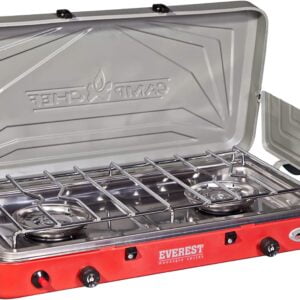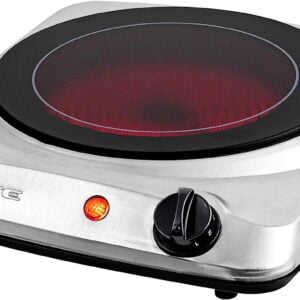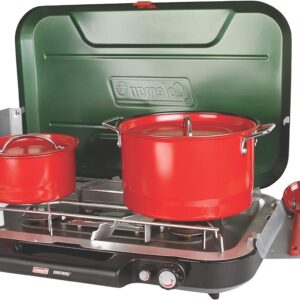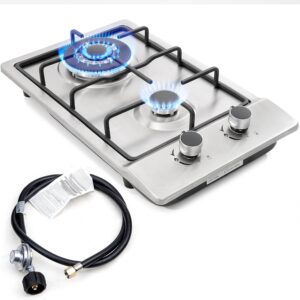Portable Stoves
Showing all 10 results
-

Coleman Triton+ 2-Burner Propane Camping Stove, Portable Grill/Stove with Adjustable Burners, Instant Push-Button Ignition, Wind Guards, and a Total of 22,000 BTUs of Cooking Power
$109.99 -
Sale!

Gas One GS-3400P Portable Dual Fuel Stove – Propane and Butane Compatible – Camping Grill/Stove with Carrying Case, Adjustable Burners, and Wind Guards
Original price was: $32.99.$30.69Current price is: $30.69. -
Sale!

Camp Chef Everest 2 Burner Portable Stove
Original price was: $169.99.$159.99Current price is: $159.99. -
Sale!

OVENTE Electric Single Infrared Burner, 7-Inch Ceramic Glass Hot Plate Cooktop with 5-Level Temperature Controls, Easy-to-Clean Stainless Steel Base, Compact Stove for Home, Dorm, and Office (Silver BGI101S)
Original price was: $34.99.$24.99Current price is: $24.99. -

Guide Gear Outdoor Wood Burning Stove, Small, Portable Cooking Solution with Chimney Pipe for Camping, Tent, Hiking, Fishing, and Backpacking Adventures
$149.00 -
Sale!

Duxtop Portable Induction Cooktop, Countertop Burner with LCD Sensor Touch, 1800 Watts – Silver 9600LS/BT-200DZ
Original price was: $159.99.$116.96Current price is: $116.96. -
Sale!

Coleman Classic Portable 3-Burner Propane Camping Stove, Instant Ignition, Wind Guards, Pressure Control, Carry Handle – 28,000 BTUs
Original price was: $179.99.$158.00Current price is: $158.00. -

Koblenz Victoria 4-Burner Gas Stove, Bronze, 16,000 BTUs, 18″ x 24
$64.90 -

Forimo Portable Propane Gas Cooktop, Single Burner Stove with Auto Ignition, Tempered Glass, Ideal for Camping, RVs, Apartments, and Outdoor Cooking
$55.99 -

Forimo 12-Inch Stainless Steel Gas Cooktop with 2 Burners, Drop-in Propane/Natural Gas Cooker, Dual Fuel 12″ Gas Stove Top for Easy Cleaning (12″W x 20″L)
$99.99
Portable Stoves: A Comprehensive Guide for Outdoor Cooking and Beyond
Portable stoves are versatile and convenient appliances that allow you to cook delicious meals on the go, whether you’re camping, hiking, picnicking, or simply need an extra cooking surface for an outdoor event. With various types and models available, choosing the right portable stove can be a daunting task. In this comprehensive guide, we’ll cover everything you need to know about portable stoves, including their types, features, fuel options, maintenance, and safety considerations.
1. Types of Portable Stoves:
There are several types of portable stoves to choose from, each with its own set of features and fuel options:
a. Camp Stoves: These are the most common type of portable stoves used for camping and outdoor cooking. They typically use propane or butane canisters as fuel and come in various sizes, from single-burner to multi-burner models.
b. Backpacking Stoves: Designed for lightweight and compactness, backpacking stoves are ideal for hikers and outdoor enthusiasts who need a minimalist cooking solution. They usually use isobutane or alcohol as fuel and are known for their efficiency and portability.
c. Solid-Fuel Stoves: These stoves use solid fuels such as wood, charcoal, or tablets. They are popular for their eco-friendliness and reliability, especially in areas where canister fuel might be scarce.
d. Electric Stoves: Portable electric stoves are convenient for outdoor events with access to electricity. They come in various designs, from single-plate burners to electric griddles.
2. Fuel Options:
The choice of fuel for your portable stove is an essential consideration, as it affects the stove’s performance and convenience:
a. Propane and Butane: Propane and butane canisters are common choices for camp stoves due to their high energy density and ease of use. They provide a clean and efficient burn, making them ideal for most outdoor cooking needs.
b. Isobutane: Isobutane canisters are popular for backpacking stoves because of their lightweight and compact design. They offer good performance in cold weather and high altitudes.
c. Alcohol: Alcohol stoves are lightweight and eco-friendly, using denatured alcohol as fuel. They are suitable for simple cooking tasks and are often used in ultralight backpacking.
d. Wood and Charcoal: Solid-fuel stoves are versatile and cost-effective, as they use readily available natural resources. They are ideal for campfires and locations where canister fuels might not be accessible.
3. Features to Consider:
When choosing a portable stove, consider the following features based on your needs and preferences:
a. Burner Type: Decide between single-burner and multi-burner models, depending on the number of people you’ll be cooking for and the complexity of your meals.
b. Size and Weight: Consider the stove’s size and weight, especially if you’ll be carrying it during outdoor activities like hiking or backpacking.
c. Ignition Type: Some stoves have built-in ignition systems, while others require a lighter or matches to start the flame.
d. Heat Control: Look for stoves with adjustable flame control for precise temperature adjustments.
e. Cooking Surface: Consider the size and material of the cooking surface to accommodate your cookware and ensure even heat distribution.
f. Wind Resistance: Some stoves come with windshields or wind-resistant designs, ensuring better performance in windy conditions.
g. Portability: Opt for stoves with foldable legs, carrying handles, or compact designs for easy transport and storage.
4. Maintenance and Cleaning:
To ensure your portable stove’s longevity and efficiency, perform regular maintenance and cleaning:
a. Clean After Each Use: Wipe off spills and food residues after each cooking session using a mild detergent and a non-abrasive sponge.
b. Remove Burner Heads: If possible, remove the burner heads for deeper cleaning to prevent clogging and ensure proper fuel flow.
c. Inspect Fuel Lines: Regularly inspect fuel lines for any signs of damage, wear, or leaks. Replace any faulty components promptly.
d. Store Properly: Keep your portable stove in a dry and clean place when not in use, and protect it from extreme temperatures.
5. Safety Considerations:
Safety is paramount when using a portable stove, especially in outdoor settings. Follow these safety tips:
a. Stability: Ensure the stove is placed on a stable and level surface to prevent tipping.
b. Ventilation: Use the stove in a well-ventilated area to prevent carbon monoxide buildup.
c. Keep Away from Flammables: Maintain a safe distance from flammable materials, including tents, fabrics, and other combustibles.
d. Supervise While Cooking: Never leave the stove unattended while it’s in use, especially with children or pets around.
e. Proper Fuel Storage: Store fuel canisters away from heat sources and in a cool, well-ventilated area.
6. Environmental Impact:
Consider the environmental impact of your choice of stove and fuel. Opt for stoves that are more eco-friendly, such as solid-fuel stoves or those using isobutane or alcohol. Practice Leave No Trace principles during outdoor cooking and adhere to local regulations for fire safety and campfire restrictions.
In conclusion, portable stoves are versatile and indispensable tools for outdoor cooking and beyond. Whether you’re camping, hiking, or hosting an outdoor event, these stoves provide a convenient and efficient solution for preparing meals on the go.
Consider the type of stove, fuel options, features, maintenance, and safety considerations to select the perfect portable stove that suits your needs and cooking preferences. With a well-chosen and properly maintained portable stove, you can savor delicious meals, create lasting memories, and enjoy the great outdoors to the fullest.





